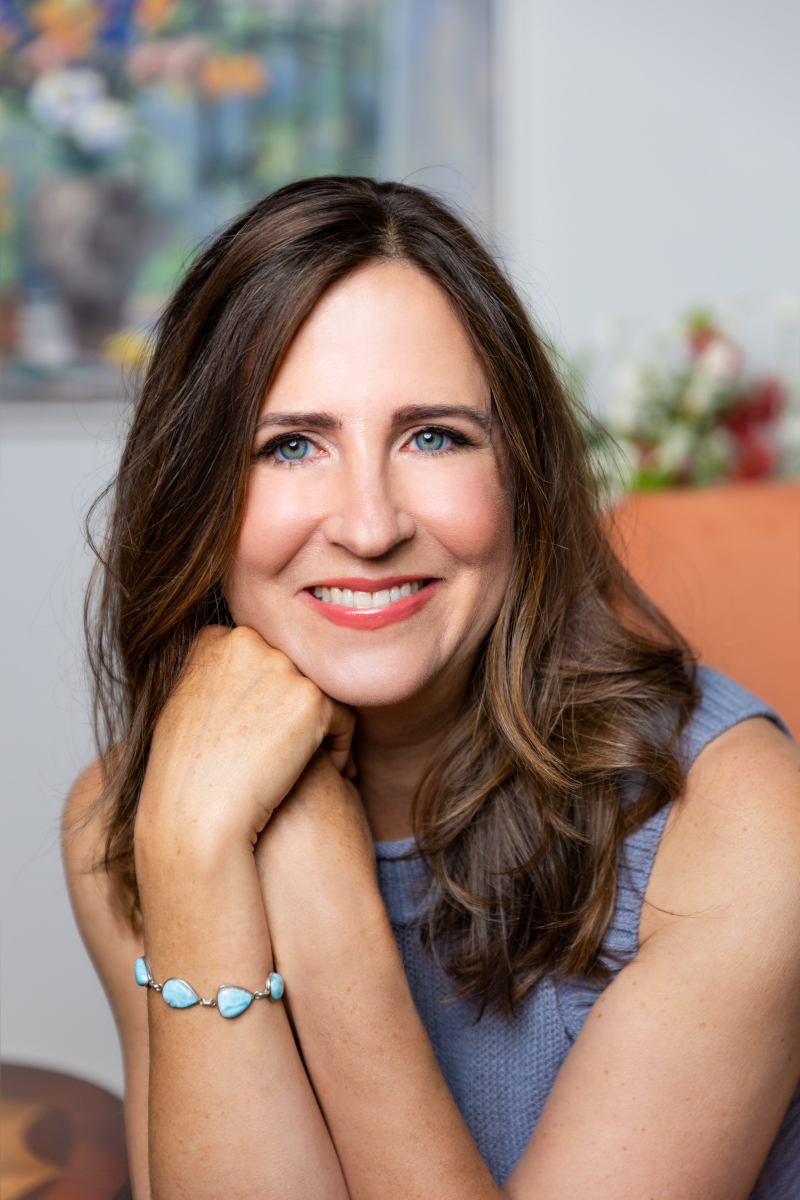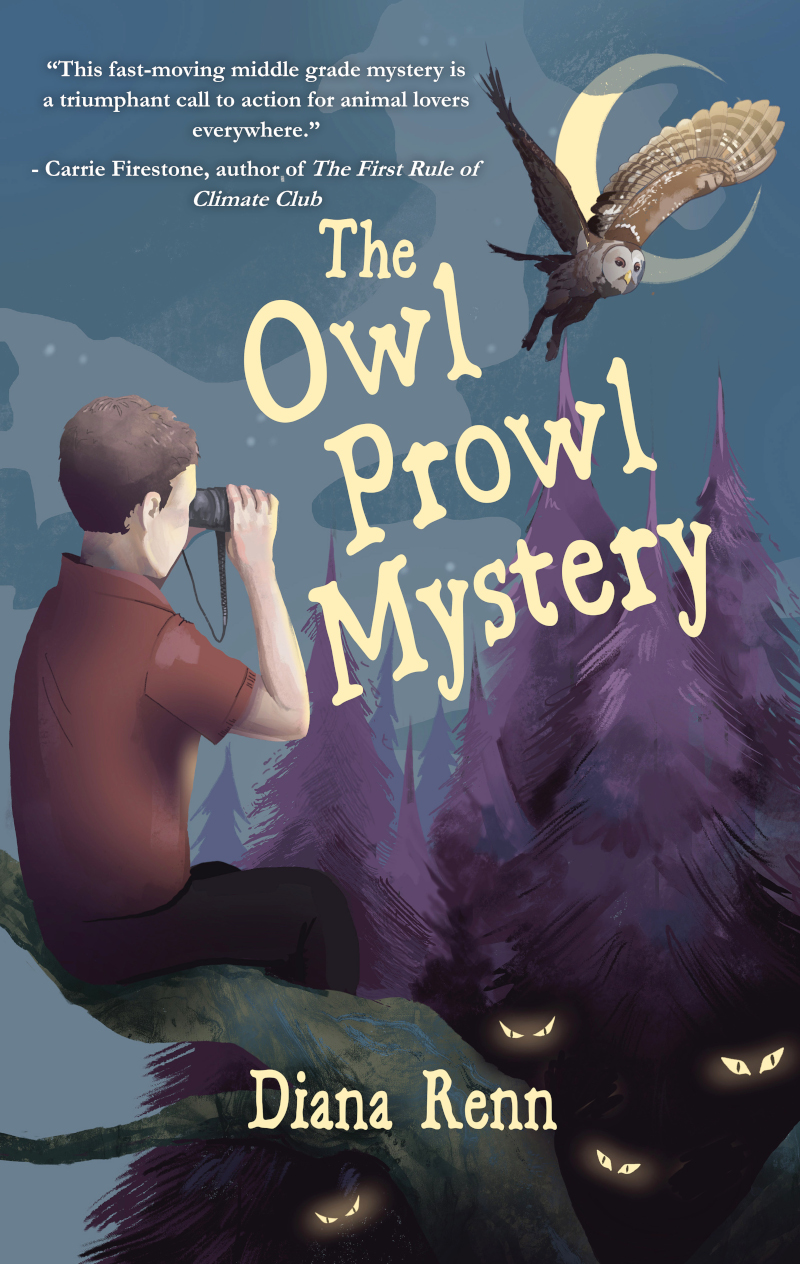
I talked with Dianna Renn, the author of five middle grade and YA novels, including The Owl Prowl Mystery (Fitzroy Books / Regal House, coming 8/13/24) and Trouble at Turtle Pond, which was named a 2023 Green Earth Book Award Honor Book by the Nature Generation and a Massachusetts Book Award “Must-Read.” Diana is also the author of three YA mysteries: Tokyo Heist, Latitude Zero, and Blue Voyage (Viking/ Penguin Random House). In addition, Diana writes nonfiction; she is the recipient of a Massachusetts Cultural Council Fellowship Award for creative nonfiction, and her essays have appeared in Flyway Journal of Writing and Environment, Pangyrus, WBUR’s Cognoscenti, Publishers Weekly, The Huffington Post, Mindful, Writer’s Digest, and elsewhere. She lives in a town outside of Boston, Massachusetts, in a neighborhood she shares with turtles and owls, some of which inspired her books. You can visit her online and sign up for her newsletter, Mysteries That Matter.
Mary: Hi Diana, it’s great to talk with you!
Diana: Hello! Thank you for having me on Dragonfly Eco. I am a big fan of your site!
Mary: Thank you! You have a middle grade eco-mystery set of books, starting with Trouble at Turtle Pond (2023) and its sequel, The Owl Prowl Mystery (2024), which is coming out this August. What led you to write these books, and what’s going on in them?
Diana: Trouble at Turtle Pond and The Owl Prowl Mystery are books one and two in a series but can be read out of sequence or as standalones. They feature a group of self-appointed “Backyard Rangers” who solve wildlife problems (and even crimes!) in their community. They live in a fictional town in the U.S., called Marsh Hollow (Massachusetts), which has some things in common with my town, including proximity to a wildlife refuge. The wildlife refuge in my books, however, doesn’t have a lot of funding—or oversight—which leaves room for these brave kids to step up and advocate for wildlife in the process of investigating mysteries. Prior to these books, I had written YA and adult mysteries featuring globetrotting sleuths who covered a lot of ground. I loved writing them, but I became very interested in settings and mysteries that could be found closer to home, and in nature. I’ve always been a nature enthusiast. I became much more interested in writing about it when my son was in fourth and fifth grades. His school participated in a community science project involving endangered freshwater turtles called Blanding’s turtles. As this turned into a family project—we even took ten turtle hatchlings into our guest room one summer—I realized I wanted to write about animals that people might not know much about, and the many people who work tirelessly on their behalf, including children and teachers. I wrote Trouble at Turtle Pond out of that community science work, and then realized my Backyard Rangers characters wouldn’t be satisfied if that’s the only adventure they got to have. There are more animals to save!
Mary: In your upcoming book, The Owl Prowl Mystery, the Backyard Rangers are trying to protect owls at the local Marsh Hollow. I love that fiction about middle-grade kids getting involved with natural places and species is represented in fiction! Do you know of real kids doing this kind of stuff?
Diana: Yes! Kids throughout Massachusetts, in elementary schools through high school, are working with turtles in partnership with Zoo New England’s Field Conservation Program. They help out with various projects, but the main thing they do is “headstart” turtles. Hatchlings leave the care of foster families in the community and go into the schools and even into some local libraries. Kids get to help feed them and monitor their growth. Headstarted turtles spend the academic year being very well cared for. By not hibernating, and by not being eaten in the wild when they are very small, they grow faster, and they have a better chance of survival. They are released to local ponds in the spring. Biologists continue to track and monitor their health. Some of the earliest graduates of this headstarting program are now reaching reproductive age—seventeen, eighteen years old. For the Blanding’s turtles in our area, this is very exciting, as the goal is to bring the population back to the level it was fifty years ago. In addition to caring for turtles in their classrooms, kids in my town, and my state, do lots of other things to advocate for their well-being. They raise awareness by doing poster presentations or hosting “turtle night” for families at the school. They raise money, selling crafts and lemonade. The kids in my son’s fourth-grade class raised over $800.00 one year! I wanted to write a book that captured some of that energy and effort. I wanted the characters to explore different ideas for how to help turtle—or any local wildlife. In my book, however, this type of headstarting program is in a very fledgling stage. I needed to remove some adults from the picture, and to give the kids in my book space to solve problems and figure things out on their own—though there are adult characters to help them when needed.
Empowered by their experience helping turtles, the characters in my series go on to help owls in Book Two because they’ve learned how vulnerable all animals can be in their community, and what happens when people don’t pay attention. In The Owl Prowl Mystery, the idea of helping animals becomes a bit more complicated. What if things we are doing to help actually end up causing harm? What is the best way to help animals? Is it okay to share their photos and locations on birding apps and social media? Does that educate people, or does it cause crowds to converge on those areas and disrupt the birds’ behaviors? These are just some of the ethical questions this book wrestles with. The Rangers are ready for more complicated problems, and they don’t always agree about how best to help owls. By the way, the turtles in Book One appear in Book Two as well. They are being headstarted in classrooms when The Owl Prowl Mystery begins in the fall. The turtles are more in the background, as the focus is on birds and owls, and outdoors they’re preparing to hibernate. However, it was important for me to show the ongoing work that caring for animals involves and to make sure they had a role in Book Two.
Mary: That’s an amazing scgiik program. Where can people find your upcoming book?
Diana: The Owl Prowl Mystery can be purchased through your local indie bookstore (they can order it for you if it’s not on the shelves), online at places like Bookshop.org, and Amazon. My amazing publisher, Fitzroy Books / Regal House, is a smaller traditional press. A great way to support small-but-mighty independent publishers is to purchase books directly off their website. You can find The Owl Prowl Mystery at Regal House. The book is also available at many public libraries, or if it’s not, you can request that they order it. That’s a great way to help authors, especially those of us with smaller presses!
Mary: Have you been able to talk with school audiences or go on book tours?
Diana: Yes to both! One of my favorite types of events to do is a collaborative event between a bookstore or library and a nonprofit wildlife education group or a land trust organization. I’m passionate about connecting people, nature, and books. Stories and art are ways to help people encounter wildlife, to learn about problems and solutions and people who help. I love doing school visits, both in person and virtually, for the same reasons. I always come away inspired because I learn about the many amazing things kids are already doing to be environmental stewards. Kids are paying attention. They care. When I do school visits, it’s also an opportunity to connect with teachers and caregivers about the issues in my books, and hopefully people come away with some new perspectives or ideas. I know I do!
I jump at opportunities to talk about my Backyard Rangers books anywhere because I see it as another form of conservation work. Even if I don’t sell a book to everyone I meet, I get to talk about turtles, or owls, or issues affecting their habitats, and how we can be better neighbors to wildlife. If I make space for people of all ages to consider conservation issues, that’s a successful event for me.
Mary: Tell us about your teen/YA books.
Diana: Prior to the Backyard Rangers books that I’m writing now, I wrote three YA mysteries published by Viking / Penguin Random House: Tokyo Heist, Latitude Zero, and Blue Voyage. They take place in Japan, Ecuador, and Turkey. They’re not a series, but they all feature brave young women who stumble into mysteries while traveling, and discover their own hidden strengths in order to solve them. I loved writing these, but of the three, only one, Tokyo Heist, is currently in print. The other two are available as e-books and in libraries. This is a thing that can happen in publishing—it’s actually quite common—only I didn’t realize that when I started out. So now I’m writing for younger readers, and in settings that feel closer to home. I’m still writing mysteries because I absolutely love the genre.
I think what all of my books have in common are characters who feel small at first but solve big problems, and who discover their real strengths and passions.
Mary: Do you have anything else to add?
Diana: In the Backyard Rangers books, all the rangers have their own strengths and skills that they bring to the team. Miles Kaplan is great at making crafts and drawing, and uses those skills to advocate for owls, making posters to raise awareness, and selling owl flight flip books to raise money for a raptor rehabber. Pia Sharma is a fierce advocate for the environment, and will pound the pavement to educate people and work for change. Luke Lin, a budding actor, is often the friendly face of the Backyard Rangers who helps draw people in; his business sense also helps with their fundraising ventures. Delaney Hunt is a tech wiz, creating all gadgets and hacks—some involving trail cams—to catch culprits. Other kids who join the rangers bring fresh talents to the table.
These characters also have different ways of engaging with nature. That was a deliberate choice. Some kids throw themselves headlong into puddles and ponds, love to climb trees, and can’t be coaxed inside. Others prefer to interact with animals in a classroom or a tank, or seen from afar through binoculars. Still others prefer nature on the page. I hope that my books show the wide range of ways in which kids can experience nature and work to protect it.
Mary: Thanks so much, Diana, for all you’re doing. I love the energy and passion you have for Nature and for writing about it for kids.
